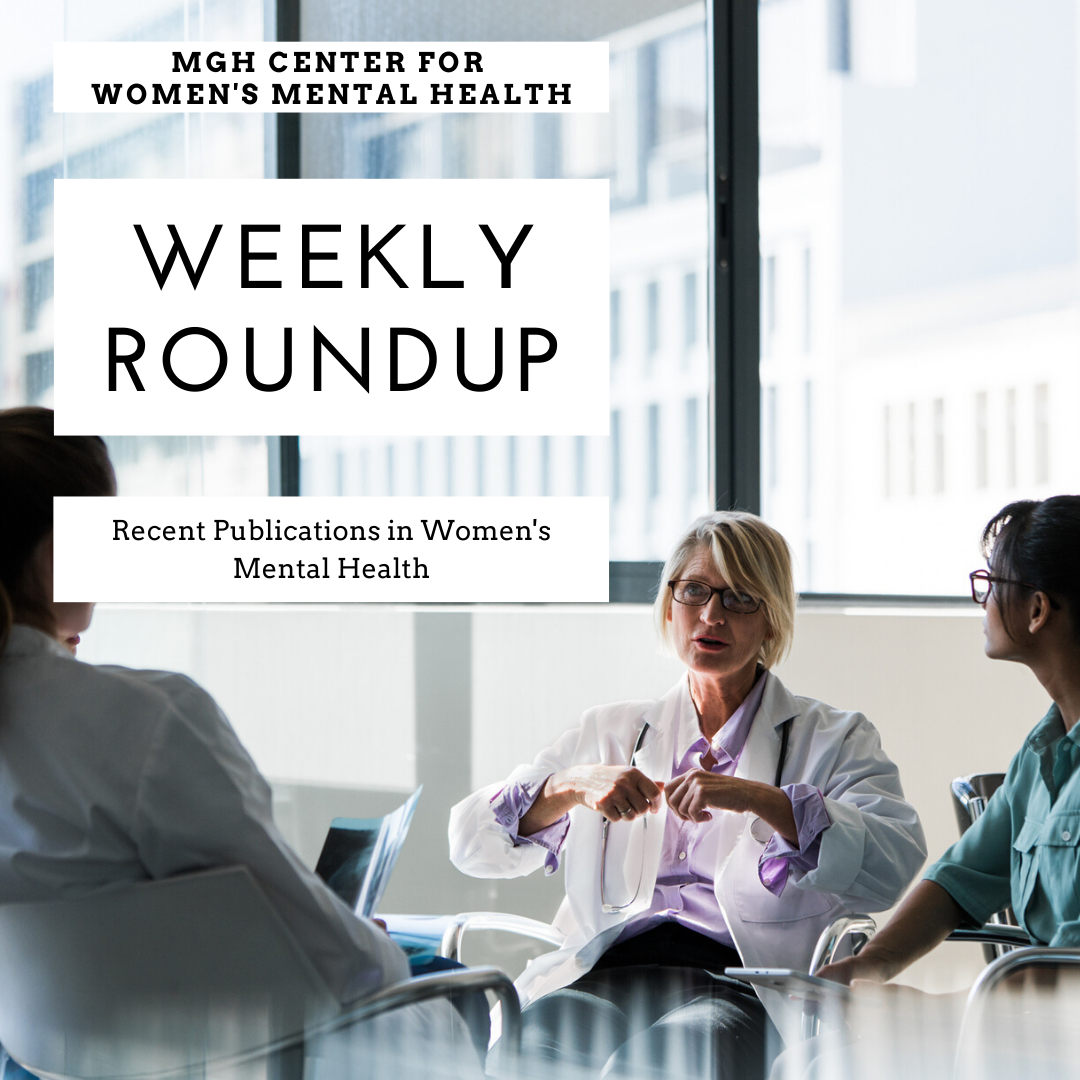Every week we review the most recent publications in women’s mental health, covering topics related to premenstrual symptoms, perinatal mood and anxiety disorders, use of medications in pregnant and breastfeeding women, perinatal substance use, and menopausal mental health.
In studies looking at the neurodevelopment of children exposed to antidepressants during pregnancy, it is often different to distinguish between the direct effects of antidepressant exposure and the indirect effects of residual psychiatric symptoms or other exposures that many be more common among women with mood and anxiety disorders (e.g., higher BMI, smoking, use of alcohol). Some of the most meticulous research we have in this area comes from Dr. Timothy Oberlander and his colleagues at the University of British Columbia, Vancouver. In a new report from this group, Dhaliwal and colleagues look at the impact of maternal depression and prenatal exposure to antidepressants children at six years of age. This study shows us just how difficult it is to answer these important questions; not only must we take into consideration exposures that occur during pregnancy, we must look carefully at environmental exposures present at the time of assessment– in this study, household chaos — can also affect outcomes.
For more detailed descriptions of many of these topics, you can sign up to receive our weekly CWMH NEWSLETTER which comes out every Thursday.
Ruta Nonacs, MD PhD
PMS AND PMDD |
| No articles this week
|
INFERTILITY AND MENTAL HEALTH |
| Maternal Mental Health in Assisted and Natural Conception: A Prospective Cohort Study.
Furmli H, Seeto RA, Hewko SL, Dalfen A, Jones CA, Murphy KE, Bocking A. J Obstet Gynaecol Can. 2019 Nov;41(11):1608-1615. Women who conceived with ART demonstrated a decreased likelihood of depression compared with women who spontaneously conceived (SC) at 24-28 weeks gestation (Edinburgh Postnatal Depression Scale: ART 3.6% vs. SC 15%; P < 0.01). There was no difference in self-reported depression, anxiety, or perceived stress between groups at 12-16 weeks gestation or at 6-10 weeks postpartum.
|
PSYCHIATRIC ILLNESS DURING PREGNANCY |
| Effects of a Brief Electronic Mindfulness-Based Intervention on Relieving Prenatal Depression and Anxiety in Hospitalized High-Risk Pregnant Women: Exploratory Pilot Study.
Goetz M, Schiele C, Müller M, Matthies LM, Deutsch TM, Spano C, Graf J, Zipfel S, Bauer A, Brucker SY, Wallwiener M, Wallwiener S. J Med Internet Res. 2020 Aug 11;22(8):e17593. There was a high prevalence of peripartum depression and anxiety among hospitalized high-risk pregnant women: 39% (26/67) of the study participants in the first assessment and 41% (16/39) of the participants in the second assessment. achieved EPDS scores above the cutoff value for minor/major depression. After completing the 1-week electronic course on mindfulness, the participants showed a significant reduction in anxiety levels (P<.03). No significant changes in depressive symptoms (measured with the EPDS) were found after completing the intervention. Dhaliwal G, Weikum WM, Jolicoeur-Martineau A, Brain U, Grunau RE, Oberlander TF. BJPsych Open. 2020 Sep 7;6(5):e106. doi: 10.1192/bjo.2020.73. PMID: 32892791 Free article. When household chaos was low, children of mothers who were not depressed during pregnancy had better executive functioning than children of prenatally depressed mothers, regardless of whether the mothers were SSRI-treated. However, when household chaos was high, SSRI-exposed children of mothers who were not depressed during pregnancy had poorer executive functions at 6 years of age compared with SSRI-exposed children whose mothers were symptomatic during pregnancy. Taylor CL, Munk-Olsen T, Howard LM, Vigod SN. BJPsych Open. 2020 Aug 28;6(5):e97. Free article. Data derived from the electronic health record have demonstrated that fertility rates in women with schizophrenia have increased over time and have enabled documentation of the course of illness in relation with pregnancy, showing the early postpartum as the time of highest risk.
|
MEDICATIONS AND PREGNANCY |
| Gabapentin in pregnancy and the risk of adverse neonatal and maternal outcomes: A population-based cohort study nested in the US Medicaid Analytic eXtract dataset.
Patorno E, Hernandez-Diaz S, Huybrechts KF, Desai RJ, Cohen JM, Mogun H, Bateman BT. PLoS Med. 2020 Sep 1;17(9):e1003322. Free article. In this large population-based study, there was no evidence for an association between gabapentin exposure during early pregnancy and major malformations overall, although there was some evidence of a higher risk of cardiac malformations. Smearman EL, Hendrix CL, Winiarski DA, Johnson KC, Smith AK, Ousley OY, Stowe ZN, Newport DJ, Brennan PA. Dev Psychopathol. 2020 Feb;32(1):21-30. Free article. Direct assessments suggest an association between prenatal SRI exposure and reduced pragmatic language scores, but not autism spectrum disorder (Autism Diagnostic Observation Schedule). These discrepancies point to issues regarding how ASD is assessed, and the possibility that SRIs may be more strongly associated with language or other broader behaviors that coincide with ASD.
|
POSTPARTUM PSYCHIATRIC ILLNESS |
| The EMDR Recent Birth Trauma Protocol: a pilot randomised clinical trial after traumatic childbirth.
Chiorino V, Cattaneo MC, Macchi EA, Salerno R, Roveraro S, Bertolucci GG, Mosca F, Fumagalli M, Cortinovis I, Carletto S, Fernandez I. Psychol Health. 2020 Jul;35(7):795-810. Most of the women improved their post-partum post-traumatic stress symptoms after only one treatment session. EMDR was more effective than treatment as usual (TAU) in reducing the proportion of women with postpartum post-traumatic stress symptoms at 6-weeks’ postpartum (78.9% EMDR vs. 39.9% TAU; p = .020). Primacy of (hypo) mania in the postpartum period: a concept worth considering. Sharma V, Viguera AC, Florio AD, Mazmanian D, Koukopoulos A, Sani G, Palagini L, Özerdem A. Bipolar Disord. 2020 Aug 28.
|
MEDICATIONS AND BREASTFEEDING |
| No articles this week
|
PERINATAL SUBSTANCE USE |
| Polysubstance Use Among Pregnant Women With Opioid Use Disorder in the United States, 2007-2016.
Jarlenski MP, Paul NC, Krans EE. Obstet Gynecol. 2020 Sep;136(3):556-564 Over the past decade, polysubstance use among pregnant women with opioid use disorder has increased more rapidly in rural compared with urban counties in the United States, with amphetamines and tobacco use increasing most rapidly.
|
MATERNAL MENTAL HEALTH AND CHILD OUTCOMES |
| Maternal Depressive Symptoms and Developmental Delay at Age 2: A Diverse Population-Based Longitudinal Study.
Chorbadjian TN, Deavenport-Saman A, Higgins C, Chao SM, Yang JH, Koolwijk I, Vanderbilt DL. Matern Child Health J. 2020 Aug 11. Using the Patient Health Questionnaire-2 (PHQ-2) to survey participants before, during and after pregnancy (at 4 months and 2.5 years). Language, cognitive/adaptive, motor, and social-emotional delays for surveyed toddlers at 2.5 years of age were 7.7%, 4.0%, 1.2%, and 14.2%. Mothers reporting depressive symptoms at all four time points were significantly more likely to report a social-emotional delay in their child (aOR = 4.39).
|
MENOPAUSE AND MENTAL HEALTH |
| No articles this week
|
OTHER TOPICS IN WOMEN’S MENTAL HEALTH |
| No articles this week |




Leave A Comment